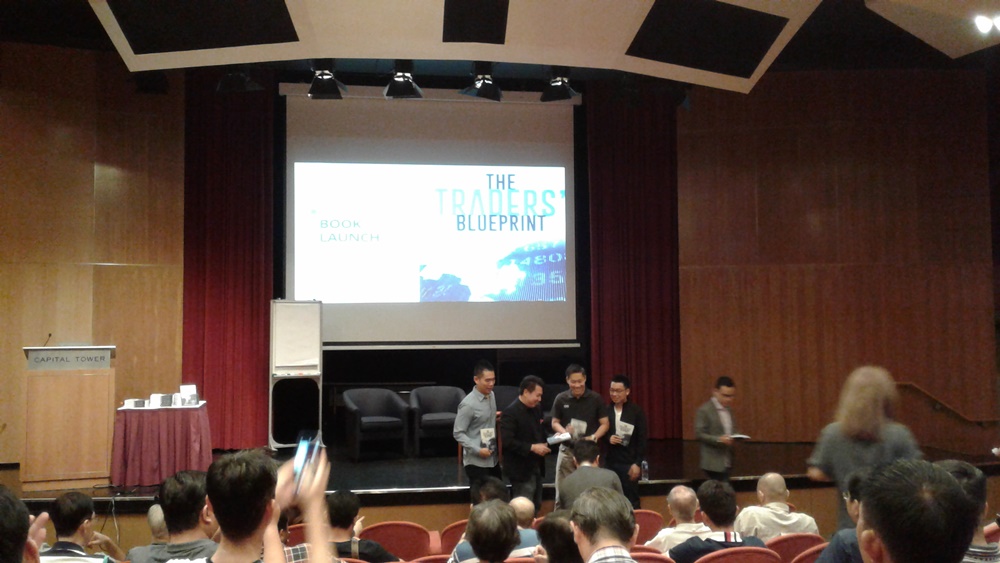Here are 8 takeaways from the Traders’ Blueprint Book Launch on 5 May 2018. For those who are interested in trading and want to learn more, but missed the session, here are the takeways from Collin Seow, Marc Liu, Rayner Teo and Alex Yeo.
1. Ride your winners
Let your winners run and cut your losses. This is because you won’t know which will be your winners at the beginning.
2. Risk management to contain your losses.
Have a stop loss amount of 1% to 2% of the trading amount for each trade. This is so that you don’t blow your trading account by protecting your capital.
3. Need to focus on a niche that makes sense to you
This is so that you don’t go into analysis-paralysis (by analysing too much and into too many areas), or keep switching strategy without fine-tuning and improving your strategy first.
4. Don’t make trading your life
There are other areas of your life besides trading. Don’t live your life just for trading. This is when Marc shared as a proprietary trader (when a trader trades with a firm’s money and share profits with the firm), the stress level is very high, he did it for 1 to 2 years but found it unsustainable.
Rayner also shared how when he worked as a proprietary trader, his day would start at 7 am and end late at night like 10 pm. Also, you would need to pay for desk fee (from $1000 to $5000) before you even make money. There is a lot of stress in the job. Also, the company only take young singles because of the long hours.
5. Resources to start investing in options for beginners
Alex, who trades options, shared the following two books that can help beginners learn more about options:
“The Complete Guide to Option Selling” by James Cordier and “The Art and Science of Technical Analysis” by Adam Grimes which is about price action.
6. View of US market and Singapore market in 2018
Philips Securities shared that they feel that the equity market trend is still intact as long as S&P500 is above 2600 points and strong support at 200 MA.
However, the market is very volatile in 2018, so buy-and-hold strategy might not be the best. Investors can consider using CFDs to hedge their long-term holdings.
The authors trade mainly the US market. All four feel that the US market is still in the uptrend and most feel that the support is at 2600 points and as long as price is above the 200 MA, the uptrend would still be intact.
Alex commented that for the Singapore market, we have not even reached the all time high of 3800 points before the recession in 2007, so we haven’t reach the exuberance level yet for a likely market crash.
7. Is there a technical indicator for stock and options that has the highest success rate?
Alex, who trades options, shared that options is a derivative and the value is derived from the underlying assets. He explored a lot of indicators and found two, ichimoku cloud and pivot point, which works for him when trading options.
Marc said that there is no one indicator that gives the highest success. Maybe, one indicator might work for a period of time only. For himself, he uses Stochastic RSI and CCI.
Collin uses MA and CCI. He shared that these are not the best indicators but are easy for him to understand. The indicators can help you get a feel of the market and does not mean you must trade with these indicators. To Collin, trading is looking at the big picture, using the top-down approach, looking for strong stock to buy and then using technical analysis for entry and exit.
For Rayner, he uses MA and ATR. ATR measures the amount of volatility. He uses ATR to set stop loss, so that there is enough room for the trade to move. Rayner cautioned that indicators are derivatives of prices, so we need to know the maths behind the indicators before using them.
8. What is the biggest challenge of trading full time from home office?
For those who are thinking of trading full time from home, these traders were against the idea.
To Marc, he would need to go somewhere to trade, as if he stay at home, there will be distractions. He would suggest that one does not trade full time at home as looking at the computer screen all day is not healthy.
Rayner also suggested that one does not do it full time. He advised that one keep their full-time job and start trading mid-term and long-term trends. Also have other sources of income. Rayner himself conducts classes.
Similarly, Collin echoed the other two. He feels that one should not begin with trading full time at home. If one does want to trade full time, going into an office space and trading together with a few other traders, might be a better option.




2 comments
Hello Tin Peng. I was surprised to see this post and you did a really good summary! Thumbs up! Are you trading actively?
Author
Hi Alex,
It’s a nice feeling to get positive comments from readers. Thanks for dropping by this blog 🙂
I do some investing and am currently learning how to trade. So, the seminar has been a good learning experience.